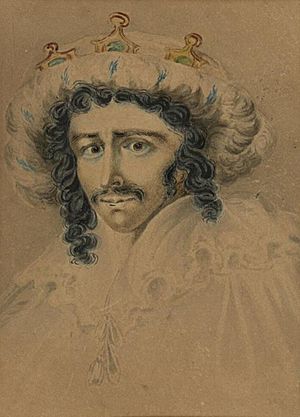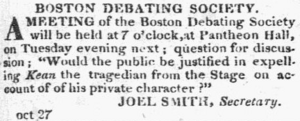Edmund Kean facts for kids
Quick facts for kids
Edmund Kean
|
|
|---|---|

Kean as Sir Giles Overreach in Massinger's A New Way to Pay Old Debts
|
|
| Born | 4 November 1787 Westminster, London
|
| Died | 15 May 1833 (aged 45) |
| Nationality | British |
| Occupation | Actor |
| Spouse(s) | Mary Chambers |
| Children | Charles Kean |
Edmund Kean (born November 4, 1787 – died May 15, 1833) was a very famous British stage actor. He was especially known for his amazing performances in Shakespeare's plays. Kean performed in many major cities around the world, including London, New York, and Paris. He was known for his powerful acting style.
Contents
Edmund Kean: A Famous Actor
His Early Life and First Steps on Stage
Edmund Kean was born in Westminster, London. His mother, Anne Carey, was an actress. His father was likely Edmund Kean, who worked for an architect.
Edmund first appeared on stage when he was only four years old! He played Cupid in a ballet called Cymon. As a child, he was lively and clever. He faced tough times and didn't have much discipline. This helped him become self-reliant, but also led to some wild habits.
Around 1794, some kind people paid for him to go to school. He did well, but he found the rules too strict. So, he became a cabin boy on a ship in Portsmouth. Life at sea was even more difficult. He cleverly pretended to be deaf and lame to get off the ship in Madeira.
When he returned to England, his uncle, Moses Kean, took care of him. Moses was an entertainer who taught Edmund about pantomime and introduced him to Shakespeare's plays. At the same time, an actress named Charlotte Tidswell, who had been kind to him since he was a baby, taught him how to act.
After his uncle passed away, Charlotte Tidswell continued to guide him. Edmund began to study Shakespeare's main characters. He developed his own unique way of playing these roles. His style was very different from John Philip Kemble, who was considered the best actor at the time.
Becoming Known as an Actor
When he was 14, Edmund got a job playing main characters for 20 nights at the York Theatre. He performed as Hamlet, Hastings, and Cato.
Soon after, while he was with a traveling theater company called Richardson's Theatre, news of his talent reached King George III. The King asked him to perform at Windsor Castle. Later, he joined Saunders's circus. During a horse riding trick, he fell and broke both his legs. This accident left his ankles swollen for the rest of his life.
Around this time, he learned music from Charles Incledon, dancing from D’Egville, and fencing from Angelo. In 1807, he played leading roles in the Belfast theater with the famous actress Sarah Siddons. She first called him "a horrid little man." But after seeing his acting, she said he "played very, very well." However, she felt he was "too little of him to make a great actor." In 1808, he married Mary Chambers, who was also a leading actress. They had two sons, and one of them, Charles Kean, also became an actor.
Success at Drury Lane and in America
For several years, things looked difficult for Edmund. But in 1814, the committee of Drury Lane Theatre in London decided to give him a chance. The theater was struggling financially.
Edmund was very nervous before his first performance in London. He said, "If I succeed I shall go mad." His older son sadly passed away the day after he signed his contract with Drury Lane.
His first show at Drury Lane was on January 26, 1814. He played Shylock in Shakespeare's The Merchant of Venice. The audience loved him and cheered loudly. People at the time said Kean brought a new sense of importance and humanity to the character of Shylock. Even Jane Austen mentioned his popularity in a letter.
He continued to perform in other famous plays like Richard III, Hamlet, Othello, Macbeth, and King Lear. He showed he was a master at playing strong, emotional roles. His success was so great that he once said, "I could not feel the stage under me."
On November 29, 1820, Kean performed for the first time in New York City. He played Richard III at the Anthony Street Theatre. His trip to America was a big success. He returned to England on June 4, 1821.
Kean was the first actor to bring back the sad ending to Shakespeare's King Lear. For many years, a different version with a happy ending had been performed. Kean wanted to show the original tragic ending. He played the tragic Lear for a few shows. However, audiences didn't respond well, so he went back to the happier version.
Challenges and Later Years
Edmund Kean's personal life sometimes caused problems for his career. He faced public criticism, which led to his wife leaving him. When he returned to Drury Lane, some audiences booed him. This made him consider leaving acting for good.
He visited America again in 1825. This trip was also difficult in some cities, where he faced insults from audiences. However, in Quebec City, he was very touched by the kindness of some Huron Indians. He was even made an honorary chief of their tribe and given the name Alanienouidet. Kean's last performance in New York was on December 5, 1826, again as Richard III.
He eventually returned to England and was welcomed back by audiences. However, his health was declining. Despite this, his great acting skills still shone through during his best moments. A performance in Paris was not successful due to his health issues.
His very last appearance on stage was at Covent Garden on March 15, 1833. He played Othello, and his son, Charles Kean, played Iago. During the play, Edmund suddenly became ill. He cried out, "O God, I am dying. Speak to them, Charles," and fell into his son's arms.
He passed away a few weeks later in Surrey. He is remembered at the Parish Church in Richmond, where there is a plaque marking his grave. He is also buried in the church of All Saints in Catherington, Hampshire. His last words are said to have been, "dying is easy; comedy is hard."
His Artistic Legacy
Edmund Kean was best known for his amazing performances of Shakespeare's characters. Many people believed his most powerful role was Sir Giles Overreach in Philip Massinger's play A New Way to Pay Old Debts. When he first performed this role, the audience was so moved that they stood up together. Even the other actors were amazed by his powerful acting.
One challenge for Kean as an actor was his short height. The poet Samuel Taylor Coleridge famously said about Kean's acting, "Seeing him act was like reading Shakespeare by flashes of lightning." This meant his performances were brilliant and intense.
Interesting Facts About Kean
At the height of his fame, Kean had some unusual habits. Sometimes he would ride his horse, Shylock, wildly through the night. He even had a tame lion that he would play with in his living room!
Famous prize-fighters like Mendoza and Richmond the Black visited him. The politician Henry Grattan was also a close friend.
The French actor François Talma once said of Kean, "He is a magnificent uncut gem; polish and round him off and he will be a perfect tragedian." This meant Kean had incredible natural talent that just needed a little refining.
The life of Edmund Kean has been so interesting that it has inspired many plays and films. These include "Kean" by Jean-Paul Sartre and a play by Alexandre Dumas called Kean, ou Désordre et génie.
Theatrical Works Based on His Life
Several plays and musicals have been created about Edmund Kean's life:
- Kean, a play by Alexandre Dumas, père, 1836
- Kean, a play by Jean-Paul Sartre, 1953
- Kean, a Broadway musical, 1961
- Kean, a BBC Play of the Month with Anthony Hopkins, 1978
- Kean, a YTV biography with Ben Kingsley, 1983
- Kean IV, a play by Grigoriy Gorin, 1991
Cultural Influence
The famous British actor Peter O'Toole (who acted in the late 1900s) owned a ring that once belonged to Kean. O'Toole used this ring as inspiration when writing his autobiography. In the 1982 movie My Favorite Year, O'Toole delivered the line, "dying is easy; comedy is hard," and said it was Kean's last words.
See also
 In Spanish: Edmund Kean para niños
In Spanish: Edmund Kean para niños




